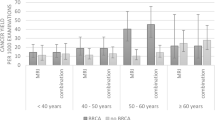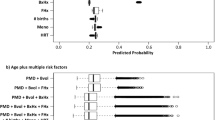Abstract
Background
The MRISC study is a screening study, in which women with an increased risk of hereditary breast cancer are screened by a yearly mammography and MRI, and half-yearly clinical breast examination. The sensitivity found in this study was 40% for mammography and 71% for MRI and the specificity was 95 and 90%, respectively. In the current subsequent study we investigated whether these results are influenced by age, a BRCA1/2 mutation, menopausal status and breast density.
Patients and methods
From November 1999 to October 2003, 1909 eligible women were screened and 50 breast cancers were detected. For the current analysis, data of 4134 screening rounds and 45 detected breast cancers were used. For both imaging modalities, screening parameters, receiver operating characteristic (ROC) curves and uni- and multivariate odds ratios (ORs) were calculated. All analyses were separately performed for age at entry (< 40, 40–49, ≥50), mutation status, menopausal status and breast density.
Results
Sensitivity of MRI was decreased in women with high breast density (adjusted OR 0.08). False-positive rates of both mammography (ORadj 1.67) and MRI (ORadj 1.21) were increased by high breast density, that of MRI by pre-menopausal status (ORadj 1.70), young age (ORadj 1.58 for women 40–49 years versus women ≥50 years) and decreased in BRCA1/2 mutation carriers (ORadj 0.74).
In all investigated subgroups the discriminating capacity (measured by the area under the ROC-curve) was higher for MRI than for mammography, with the largest differences for BRCA1/2 mutation carriers (0.237), for women between 40 and 49 years (0.227) and for women with a low breast density (0.237).
Conclusions
This report supports the earlier recommendation that MRI should be a standard screening method for breast cancer in BRCA1/2 mutation carriers.
Similar content being viewed by others
References
Vasen HFA, Haites NE, Evans DGR et al (1998) Current policies for surveillance and management in women at risk of breast and ovarian cancer: a survey among 16 european family cancer clinics. Eur J Cancer 34:1922–1926
Brekelmans CT, Seynaeve C, Bartels CC et al (2001) Effectiveness of breast cancer surveillance in BRCA1/2 gene mutation carriers and women with high familial risk. J Clin Oncol 19:924–930
Scheuer L, Kauff N, Robson M et al (2002) Outcome of preventive surgery and screening for breast and ovarian cancer in BRCA mutation carriers. J Clin Oncol 20:1260–1268
Komenaka IK, Ditkoff BA, Joseph KA et al (2004) The development of interval breast malignancies in patients with BRCA mutations. Cancer 100:2079–2083
Kriege M, Brekelmans CT, Boetes C et al (2001) MRI screening for breast cancer in women with familial or genetic predisposition: design of the Dutch national study (MRISC). Fam Cancer 1:163–168
Kriege M, Brekelmans CT, Boetes C et al (2004) Efficacy of MRI and mammography for breast-cancer screening in women with a familial or genetic predisposition. N Engl J Med 351:427–437
Warner E, Plewes DB, Hill KA et al (2004) Surveillance of BRCA1 and BRCA2 mutation carriers with magnetic resonance imaging, ultrasound, mammography, and clinical breast examination. JAMA 292:1317–1325
Leach MO, Boggis CR, Dixon AK et al (2005) Screening with magnetic resonance imaging and mammography of a UK population at high familial risk of breast cancer: a prospective multicentre cohort study (MARIBS). Lancet 365:1769–1778
Kuhl CK, Schrading S, Leutner CC et al (2005) Mammography, breast ultrasound, and magnetic resonance imaging for surveillance of women at high familial risk for breast cancer. J Clin Oncol 23:8469–8476
Litherland JC, Stallard S, Hole D et al (1999) The effect of hormone replacement therapy on the sensitivity of screening mammograms. Clin Radiol 54:285–288
Kerlikowske K, Grady D, Barclay J et al (1996) Effect of age, breast density, and family history on the sensitivity of first screening mammography. JAMA 276:33–38
Rosenberg RD, Hunt WC, Williamson MR et al (1998) Effects of age, breast density, ethnicity, and estrogen replacement therapy on screening mammographic sensitivity and cancer stage at diagnosis: review of 183,134 screening mammograms in Albuquerque, New Mexico. Radiology 209:511–518
Kolb TM, Lichy J, Newhouse JH (2002) Comparison of the performance of screening mammography, physical examination, and breast US and evaluation of factors that influence them: an analysis of 27,825 patient evaluations. Radiology 225:165–175
Tabar L, Fagerberg G, Chen HH et al (1995) Efficacy of breast cancer screening by age. New results from the Swedish two-county trial. Cancer 75:2507–2517
Fletcher SW, Black W, Harris R et al (1993) Report of the international workshop on screening for breast cancer. J Natl Cancer Inst 85:1644–1656
Carney PA, Miglioretti DL, Yankaskas BC et al (2003) Individual and combined effects of age, breast density, and hormone replacement therapy use on the accuracy of screening mammography. Ann Intern Med 138:168–175
Ciatto S, Visioli C, Paci E et al (2004) Breast density as a determinant of interval cancer at mammographic screening. Br J Cancer 90:393–396
Saarenmaa I, Salminen T, Geiger U et al (2001) The effect of age and density of the breast on the sensitivity of breast cancer diagnostic by mammography and ultasonography. Breast Cancer Res Treat 67:117–123
Banks E, Reeves G, Beral V et al (2004) Influence of personal characteristics of individual women on sensitivity and specificity of mammography in the Million Women Study: cohort study. Br Med J 329:477
Tilanus-Linthorst M, Verhoog L, Obdeijn IM et al (2002) A BRCA1/2 mutation, high breast density and prominent pushing margins of a tumor independently contribute to a frequent false-negative mammography. Int J Cancer 102:91–95
Halapy E, Chiarelli AM, Klar N et al (2005) Accuracy of breast screening among women with and without a family history of breast and/or ovarian cancer. Breast Cancer Res Treat 90:299–305
van Gils CH, Otten JD, Verbeek AL et al (1998) Effect of mammographic breast density on breast cancer screening performance: a study in Nijmegen, the Netherlands. J Epidemiol Commun Health 52:267–271
Mandelson MT, Oestreicher N, Porter PL et al (2000) Breast density as a predictor of mammographic detection: comparison of interval- and screen-detected cancers. J Natl Cancer Inst 92:1081–1087
Kavanagh AM, Mitchell H, Giles GG (2000) Hormone replacement therapy and accuracy of mammographic screening. Lancet 355:270–274
Blanks RG, Moss SM, McGahan CE et al (2000) Effect of NHS breast screening programme on mortality from breast cancer in England and Wales, 1990–8: comparison of observed with predicted mortality. Br Med J 321:665–669
Kavanagh AM, Cawson J, Byrnes GB et al (2005) Hormone replacement therapy, percent mammographic density, and sensitivity of mammography. Cancer Epidemiol Biomarkers Prev 14:1060–1064
Thurfjell EL, Holmberg LH, Persson IR (1997) Screening mammography: sensitivity and specificity in relation to hormone replacement therapy. Radiology 203:339–341
Sardanelli F, Giuseppetti GM, Panizza P et al (2004) Sensitivity of MRI versus mammography for detecting foci of multifocal, multicentric breast cancer in Fatty and dense breasts using the whole-breast pathologic examination as a gold standard. AJR Am J Roentgenol 183:1149–1157
Bluemke DA, Gatsonis CA, Chen MH et al (2004) Magnetic resonance imaging of the breast prior to biopsy. JAMA 292:2735–2742
Berg WA, Gutierrez L, NessAiver MS et al (2004) Diagnostic accuracy of mammography, clinical examination, US, and MR imaging in preoperative assessment of breast cancer. Radiology 233:830–849
Harms SE (1998) Breast magnetic resonance imaging. Semin Ultrasound CT MR 19:104–120
Heywang-Kobrunner SH, Viehweg P, Heinig A et al (1997) Contrast-enhanced MRI of the breast: accuracy, value, controversies, solutions. Eur J Radiol 24:94–108
Kinkel K, Hylton NM (2001) Challenges to interpretation of breast MRI. J Magn Reson Imaging 13:821–829
Kuhl CK, Bieling HB, Gieseke J et al (1997) Healthy premenopausal breast parenchyma in dynamic contrast-enhanced MR imaging of the breast: normal contrast medium enhancement and cyclical-phase dependency. Radiology 203:137–144
Muller-Schimpfle M, Ohmenhauser K, Stoll P et al (1997) Menstrual cycle and age: influence on parenchymal contrast medium enhancement in MR imaging of the breast. Radiology 203:145–149
Claus EB, Risch NJ, Thompson WD (1994) Autosomal dominant inheritance of early-onset breast cancer. Cancer 73:643–651
American College of Radiology (1995) Illustrated breast imaging reporting and data system (BI-RADS). 3
Berg WA, Campassi C, Langenberg P et al (2000) Breast imaging reporting and data system: inter- and intraobserver variability in feature analysis and final assessment. AJR Am J Roentgenol 174:1769–1777
Lee-Han H, Cooke G, Boyd NF (1995) Quantitative evaluation of mammographic densities: a comparison of methods of assessment. Eur J Cancer Prev 4:285–292
Sivaramakrishna R, Obuchowski NA, Chilcote WA et al (2001) Automatic segmentation of mammographic density. Acad Radiol 8:250–256
Ooms EA, Zonderland HM, Eijkemans MJC et al (2006) Mammography: inter-observer variability in breast density assesment (abstract). Fifth international meeting: endocrine treatment prevention of breast ABD gynaecological cancers
Kaas R, Kroger R, Hendriks JH et al (2004) The significance of circumscribed malignant mammographic masses in the surveillance of BRCA 1/2 gene mutation carriers. Eur Radiol 14: 1647–1653
Buist DS, Porter PL, Lehman C et al (2004) Factors contributing to mammography failure in women aged 40–49 years. J Natl Cancer Inst 96:1432–1440
Tilanus-Linthorst MM, Kriege M, Boetes C et al (2005) Hereditary breast cancer growth rates and its impact on screening policy. Eur J Cancer 41:1610–1617
Day NE, Williams DR, Khaw KT (1989) Breast cancer screening programmes: the development of a monitoring and evaluation system. Br J Cancer 59:954–958
Kriege M, Brekelmans CTM, Boetes C et al (2006, in press) Differences between first and subsequent rounds of the MRISC breast cancer screening program for women with a familial or genetic predisposition. Cancer
Adem C, Reynolds C, Soderberg CL et al (2003) Pathologic characteristics of breast parenchyma in patients with hereditary breast carcinoma, including BRCA1 and BRCA2 mutation carriers. Cancer 97:1–11
Acknowledgement
Supported by a grant (OG 98-03) from the Dutch Health Insurance Council.
Author information
Authors and Affiliations
Corresponding author
Rights and permissions
About this article
Cite this article
Kriege, M., Brekelmans, C.T.M., Obdeijn, I.M. et al. Factors Affecting Sensitivity and Specificity of Screening Mammography and MRI in Women with an Inherited Risk for Breast Cancer. Breast Cancer Res Treat 100, 109–119 (2006). https://doi.org/10.1007/s10549-006-9230-z
Received:
Accepted:
Published:
Issue Date:
DOI: https://doi.org/10.1007/s10549-006-9230-z




